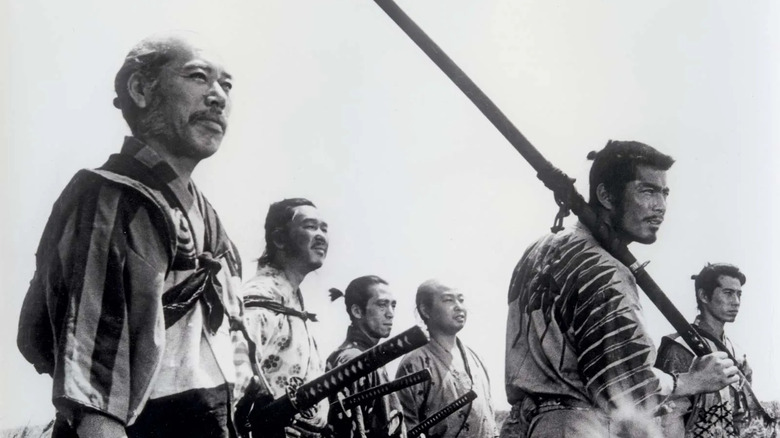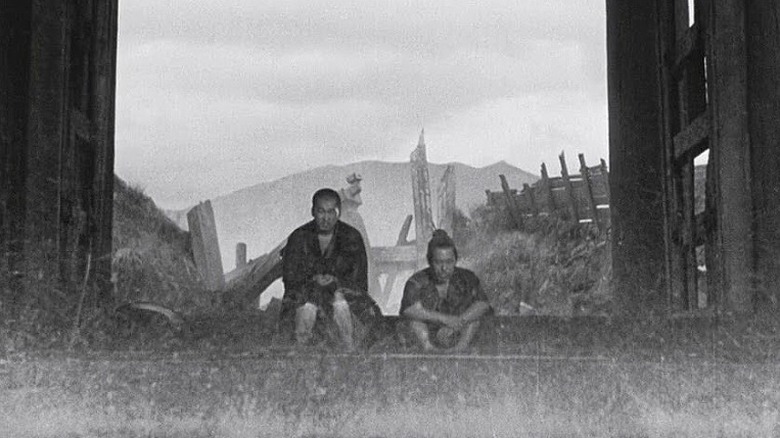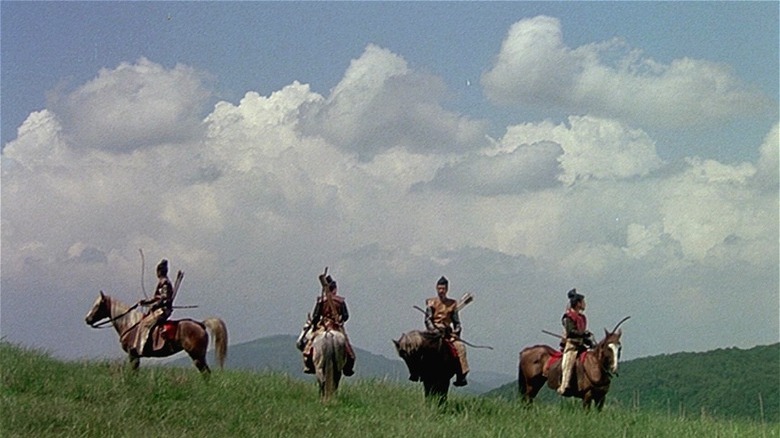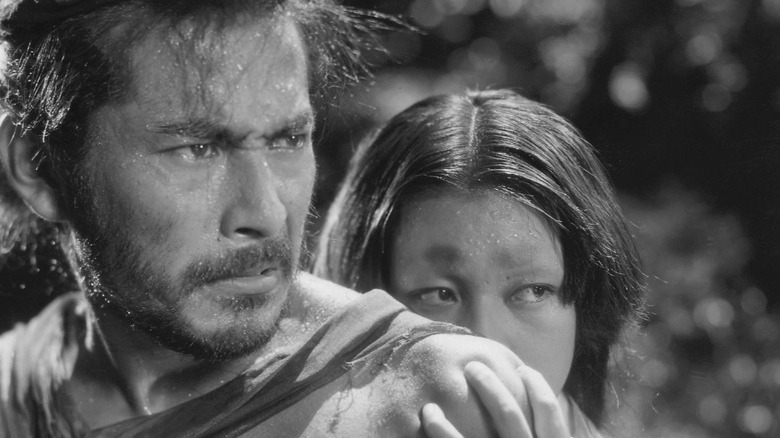Akira Kurosawa Set Out To End One Of Japanese Filmmaking's Biggest Trends
Legendary filmmaker Akira Kurosawa opened "Seven Samurai" with a group of bandits approaching a small village on horseback. Between the opening credits and the first shot, Kurosawa established the themes of civil unrest and violence that would permeate the film; the bandit scene predicts the brutal savagery that is about to play out. However, this expectation is undercut when the bandits realize they've already looted the village and plan to return later. This change in plans heightens the anxiety surrounding the forthcoming attack, replayed to audiences via a villager overhearing the exchange and running home to warn the residents. Although this scene appears standard when compared to modern movies, Kurosawa had broken the mold of an established Japanese cinematic trend in a key way.
Kurosawa's contribution to Japanese cinema (and cinema, as a whole) is multifaceted. The director imbued his films with themes that were unapologetically relevant for audiences, masterfully using camerawork and symbolism to achieve his goals and frequently relying on the interplay of light and dark to weave stunning portraits of morality. To understand how Kurosawa pioneered a new era of Japanese filmmaking, one has to look into the filmmaking trends of the times.
In a 1993 interview for the Directors Guild of Japan, Kurosawa sat down with fellow filmmaker Nagisa Oshima and discussed how he challenged the way Japanese films of his era utilized their opening shots, touching on the differences between static and dynamic filmmaking.
Breaking established norms
Kurosawa's films are known for their visually arresting qualities and the obvious care that went into framing and blocking scenes. "Rashomon," for example, features a hypnotic forest sequence, with the director capturing the sunlight filtering through the leaves and creating a controlled environment that clashes with the lead character's chaotic experiences. As "Rashomon" is about the multiplicity of the human experience, where several individuals perceive the same incident in different ways, the forest scene sets up the woodcutter's point of view with the help of visual cues.
In the interview, Kurosawa explains how this dynamic way of creating scenes is a departure from traditional Japanese films, which often opened with scenes like "a messenger com[ing] up a slope and enter[ing] a gate as he says hello." During his days as an assistant director, Kurosawa made a note of this trend and deliberately worked towards ending it once he became a director himself:
"Japanese films back then tended to be rather static. So I guess I wrote the note as a reminder that we needed to find ways to get more action into them.... There was an overall pattern evident in movies made back then, even by Shochiku ... there would be no scripts that would open a story with a bang, right in the middle of something exciting. But what if a movie opened with a character shouting a response in an action scene?"
Let's have a look at the unconventional ways in which Kurosawa chose to open some of his seminal films, such as "Ikiru," "Throne of Blood," and "Ran."
Setting up a compelling opening shot
Kurosawa's statement about opening the story with a "bang" was something he did in 1985's "Ran," which was his interpretation of Shakespeare's "King Lear." The film opens with a picturesque shot of horsemen but quickly devolves into a brutal boar hunt. This shot sets up a serious premise while allowing viewers to have an intimate look at the attitude towards warfare during the early-Meiji era, and "Ran" is still considered one of the greatest historical dramas ever made.
Kurosawa's films often talk about unending cycles of violence and its disastrous effects on human civilization. To drive this point home, Kurosawa opened "Throne of Blood," an adaptation of Shakespeare's "Macbeth," with sweeping shots of a fog-covered hillside that helped establish an eerie, desolate atmosphere. The film's haunting title track accompanies the opening, telling a grim tale about the feudal warriors who perished in battle. The omnipresent fog acts as an extension of the treacherous Spiderweb Forest, from which Washizu (Macbeth) and Miki (Banquo) emerge. Every character is in imminent danger when enveloped by the fog, and Kurosawa lays the groundwork for this recurring symbolism in the opening.
Any discussion about Kurosawa's opening shots is incomplete without his 1952 film, "Ikiru," which centers on Kanji, who has stomach cancer and learns that he will die soon. Kurosawa opens "Ikiru" with an x-ray of Kanji's stomach and a voiceover that explains his predicament: Kanji's life has been meaningless, devoid of purpose, as he has been "simply passing time without actually living his life." Kanji's lack of agency is reinforced by the way the shot is set up: we get a third-person point of view of the situation and Kanji is not in control of his narrative, as the film demolishes his sense of self from the get-go.
How Kurosawa transformed Japanese cinema
In his interview with Oshima, Kurosawa used the example of Shochiku films, which is a kabuki production and film distribution company. Most Shochiku films of the era, such as Masaki Kobayashi's "Harakiri," open with a character arriving at an estate and declaring something, which sets the plot in motion. Although "Harakiri" is a solid samurai film with plenty of merits, lesser Shochiku films that aped this formula failed to introduce thrill or intrigue in their opening moments.
Apart from lackluster opening shots, the camera movements in Japanese cinema of the times relied heavily on tracking shots or dissolves. Kurosawa employed a style that became frequently associated with his work in the form of the wipe: a bar that moves across the screen to wipe away an existing scene as it moves on to the next. There's also the axial cut, in which the camera moves towards or away from a character to emphasize a theme. A good example of this would be his "Sanshiro Sugata," in which Kurosawa uses the axial cut to frame an encounter between two people as they descend the stairs.
Oshima pointed out that Kurosawa introduced these unique methods due to a "sense of dissatisfaction, a desire to make something different." Kurosawa acknowledged that his filmmaking process was the result of a desire to steer Japanese cinema toward directions never explored. The reason why Kurosawa is so celebrated is that he dared to do something different and meaningful, all while never pandering to audiences. His unwavering passion and desire to shake things up helped mold a filmography that changed the face of cinema forever.



